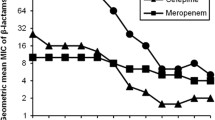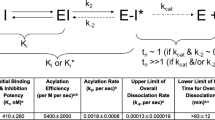Abstract
The in vitro activity of OPC-17116 was compared to that of five similar fluoroquinolones (ciprofloxacin, enoxacin, norfloxacin, ofloxacin and temafloxacin). A total of 700 isolates from recent cases of clinical bacteremia were tested. Fifty additional stock strains with well-characterized resistance mechanisms were also processed. The minimal concentrations inhibiting 90 % of strains (MIC90) ofEnterobacteriaceae species were for OPC-17116 0.015–0.5 µg/ml and for ciprofloxacin 0.015–0.25 µg/ml.Moraxella catarrhalis, Haemophilus influenzae andNeisseria gonorrhoeae were very susceptible to OPC-17116 (MIC90 0.015 µg/ml) thus being fourfold more active than ciprofloxacin. For all β-hemolytic streptococci and pneumococci OPC-17116 MICs were ≤0.5 µg/ml. The most resistant enteric bacilli were among theCitrobacter freundii andProvidencia rettgeri strains (MIC90 0.5 µg/ml).Pseudomonas aeruginosa strains were comparably susceptible to OPC-17116 (MIC90 0.5 µg/ml). Low pH and CO2 incubation had an adverse effect on OPC-17116 MICs, and resistance development was documented among current clinical isolates of staphylococci, pseudomonas and someEnterobacteriaceae.
Similar content being viewed by others
References
Gargallo D, Moros M, Coll R, Esteve M, Pares J, Xicota MA, Guinea J: Activity of E-3846: a new fluoroquinolone, in vitro and in experimental cystitis and pyelonephritis in rats. Antimicrobial Agents and Chemotherapy 1988, 32: 636–641.
Hoban DJ: Comparative in vitro activity of quinolones. Clinical and Investigative Medicine 1989, 12: 10–18.
Jones RN, Barrett MS, Erwin ME, Briggs BM, Johnson DM: In vitro activity of sparfloxacin (AT-4140, CI-978, PD131501) compared with numerous other quinolone compounds. Diagnostic Microbiology and Infectious Diseases 1991, 14: 319–330.
Chin NX, Neu HC: Ciprofloxacin: a quinolone carboxilic acid compound active against aerobic and anaerobic bacteria. Antimicrobial Agents and Chemotherapy 1984, 25: 319–326.
Fuchs PC, Barry AL, Jones RN, Thornsberry C: Evaluation of in vitro antibacterial activity of enoxacin: comparison with other orally absorbed antimicrobial agents, proposed disk diffusion test interpretive criteria, and quality control limits. Diagnostic Microbiology and Infectious Diseases 1985, 3: 213–221.
Kuono K, Inoue M, Mitsuhashi S: In vitro and in vivo antibacterial activity of AT-2266. Antimicrobial Agents and Chemotherapy 1983, 24: 78–84.
Sato K, Matsuura Y, Inoue M, Une T, Osada Y, Ogawa H, Mitsuhashi S: In vitro and in vivo activity of DL-8280: a new oxazine derivative. Antimicrobial Agents and Chemotherapy 1982, 22: 548–553.
Hardy DJ, Swanson RN, Hensey DM, Ramer RN, Bower AR, Hanson CW, Chu DTW, Fernandes PB: Comparative antibacterial activity of temafloxacin hydrochloride (A-62254) and two reference fluoroquinolones. Antimicrobial Agents and Chemotherapy 1987, 31: 1768–1774.
National Committee for Clinical Laboratory Standards: Approved standard, M7-A2: standard methods for dilution antimicrobial susceptibility test for bacteria that grow aerobically. 2nd ed. NCCLS, Villanova, PA, 1990.
Jorgensen JH, Redding JS, Maher LA, Howell AW: Improved medium for antimicrobial susceptibility testing ofHaemophilus influenzae. Journal of Clinical Microbiology 1987, 25: 2105–2113.
Jorgensen JH, Maher LA, Howell AW: Use of Haemophilus Test Medium for broth microdilution antimicrobial susceptibility testing ofStreptococcus pneumoniae. Journal of Clinical Microbiology 1990, 28: 430–434.
Jones RN, Gavan TL, Thornsberry C, Fuchs PC, Gerlach EH, Knapp JS, Murray P, Washington JA: Standardization of disk diffusion and agar dilution susceptibility tests forNeisseria gonorrhoeae: interpretive criteria and quality control guidelines for ceftriaxone, penicillin, spectinomycin, and tetracycline. Journal of Clinical Microbiology 1989, 27: 2758–2766.
National Committee for Clinical Laboratory Standards: Approved standard, M11-A2: standard reference agar dilution procedure for antimicrobial susceptibility testing for anaerobic bacteria. NCCLS, Villanova, PA, 1991.
Chin NX, Brittain DC, Neu HC: In vitro activity of Ro 23-6240: a new fluorinated 4-quinolone. Antimicrobial Agents and Chemotherapy 1986, 29: 675–680.
Thys JP, Jacobs F, Byl B: Role of quinolones in the treatment of bronchopulmonary infections, particularly pneumococcal and community-acquired pneumonia. European Journal of Clinical Microbiology and Infectious Disease 1991, 10: 304–315.
Wolfson JS, Hooper DC: Fluoroquinolone antimicrobial agents. Clinical Microbiology Review 1989, 2: 378–424.
Author information
Authors and Affiliations
Rights and permissions
About this article
Cite this article
Sader, H.S., Erwin, M.E. & Jones, R.N. In vitro activity of OPC-17116 compared to other broad-spectrum fluoroquinolones. Eur. J. Clin. Microbiol. Infect. Dis. 11, 372–381 (1992). https://doi.org/10.1007/BF01962081
Issue Date:
DOI: https://doi.org/10.1007/BF01962081




